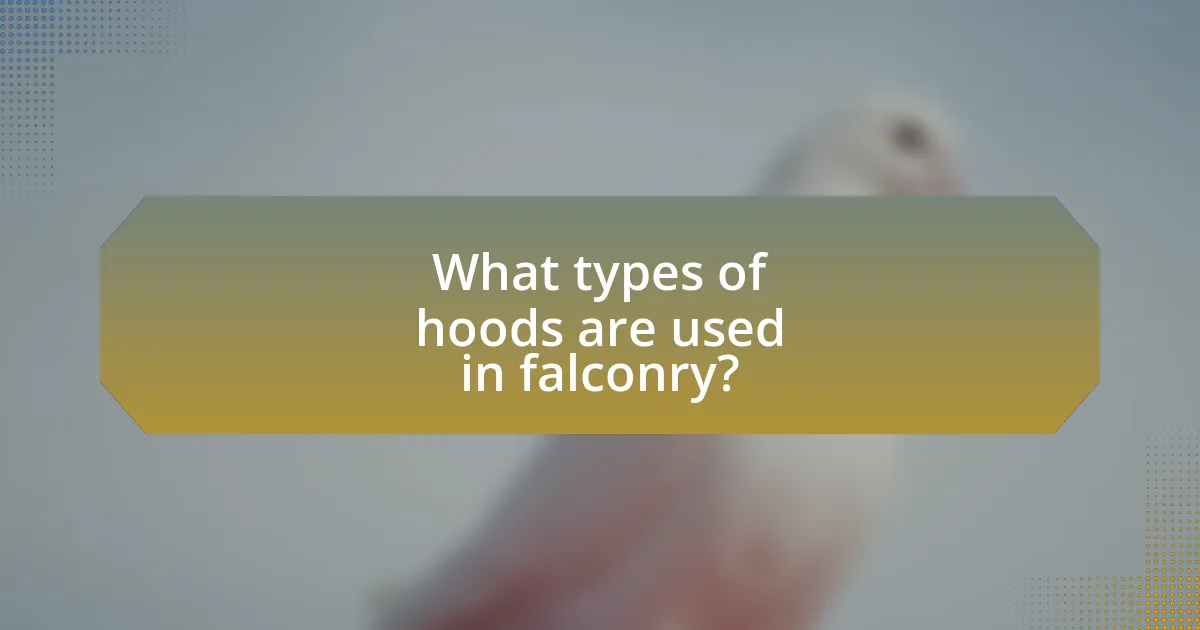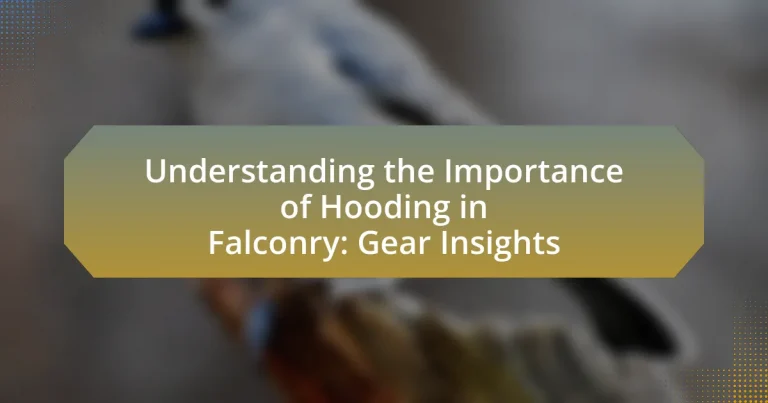Hooding in falconry is the practice of placing a hood over a bird of prey’s head to restrict its vision, which serves to calm the bird and reduce stress during training and transport. This article explores the benefits of hooding, including its psychological effects on raptors, its influence on training processes, and its historical significance in falconry. It also discusses the various types of hoods available, the materials used, and best practices for fitting, cleaning, and maintaining hoods to ensure the well-being of the birds. Additionally, the article highlights the risks associated with not using a hood and the importance of proper storage and care to extend the lifespan of this essential falconry gear.
What is Hooding in Falconry?

Hooding in falconry refers to the practice of placing a hood over a bird of prey’s head to restrict its vision. This technique is essential for calming the bird, reducing stress, and preventing it from becoming overly agitated or aggressive. The hood allows falconers to manage their birds more effectively during transportation, training, and when in the presence of potential distractions. Historical evidence shows that hooding has been utilized for centuries, with references dating back to ancient falconry texts, indicating its long-standing significance in the care and handling of raptors.
How does hooding benefit falconry practices?
Hooding benefits falconry practices by calming the bird and reducing stress during transport and handling. When a falcon is hooded, its vision is obstructed, which minimizes distractions from the environment, allowing the bird to feel more secure. This practice is essential for maintaining the bird’s focus and readiness for hunting, as it helps prevent overstimulation and anxiety. Studies have shown that hooding can lead to improved performance in hunting scenarios, as the bird remains more composed and attentive to the falconer’s commands.
What are the psychological effects of hooding on birds of prey?
Hooding birds of prey primarily induces a calming effect, reducing stress and anxiety in these raptors. When hooded, birds experience a decrease in visual stimuli, which helps to minimize their agitation and allows them to feel more secure. Research indicates that hooding can lead to lower heart rates and a more relaxed demeanor, as the absence of visual distractions allows the birds to focus on their internal state rather than external threats. This practice is essential in falconry, as it aids in the training process and enhances the bond between the falconer and the bird.
How does hooding influence the training process of falcons?
Hooding significantly influences the training process of falcons by reducing their stress and anxiety levels during training sessions. When a falcon is hooded, it limits its vision, which helps to calm the bird and makes it more receptive to training commands. This calming effect is crucial, as it allows falconers to establish a bond with the bird and facilitate learning. Studies have shown that hooding can lead to improved focus and performance in falcons, as they are less distracted by their surroundings.
Why is hooding considered essential for falconers?
Hooding is considered essential for falconers because it helps to calm and control the bird of prey, reducing stress and anxiety. The hood restricts the bird’s vision, which minimizes distractions from the environment, allowing the falconer to manage the bird more effectively during training and hunting. This practice is rooted in historical falconry techniques, where the use of hoods has been documented for centuries, demonstrating its long-standing significance in ensuring the well-being and performance of the raptor.
What risks are associated with not using a hood?
Not using a hood in falconry poses several risks, primarily related to the bird’s stress and safety. Without a hood, a falcon may become overstimulated by its environment, leading to anxiety and erratic behavior. This heightened stress can result in injuries, as the bird may attempt to escape or react aggressively to perceived threats. Additionally, the absence of a hood can hinder the falcon’s ability to focus during training or hunting, negatively impacting its performance. Studies indicate that hoods help in calming birds, thereby reducing the likelihood of such adverse reactions.
How does hooding enhance the safety of both the falcon and the falconer?
Hooding enhances the safety of both the falcon and the falconer by reducing the falcon’s stress and preventing it from becoming startled or aggressive. When a falcon is hooded, it is less likely to react to sudden movements or loud noises, which can lead to dangerous situations for both the bird and the handler. This controlled environment allows the falconer to manage the bird more effectively, minimizing the risk of injury during handling or transport. Additionally, hooding helps to maintain the falcon’s focus and calmness, which is crucial during training and hunting, thereby ensuring a safer experience for both parties involved.
What types of hoods are used in falconry?

In falconry, the primary types of hoods used are traditional leather hoods, modern synthetic hoods, and custom-fitted hoods. Traditional leather hoods are crafted from soft leather, providing comfort and durability, while modern synthetic hoods are made from lightweight materials that offer weather resistance and ease of cleaning. Custom-fitted hoods are tailored specifically to the bird’s measurements, ensuring a secure fit that enhances the bird’s comfort and effectiveness during training and hunting. Each type serves the essential purpose of blocking the bird’s vision to reduce stress and maintain calmness, which is crucial for successful falconry practices.
How do different materials affect the performance of hoods?
Different materials significantly affect the performance of hoods in falconry by influencing factors such as weight, breathability, and durability. For instance, leather hoods provide excellent durability and a snug fit, which helps in reducing stress for the bird, while also being breathable enough to prevent overheating. In contrast, synthetic materials like nylon are lighter and often more water-resistant, which can enhance comfort during wet conditions but may lack the breathability of leather. Additionally, the choice of material can impact the hood’s ability to block light; thicker materials tend to block more light, which is crucial for calming the bird. Studies have shown that the right material choice can lead to improved behavior and performance in trained birds, highlighting the importance of selecting appropriate materials for specific conditions and purposes in falconry.
What are the advantages of leather versus synthetic materials?
Leather offers superior durability and breathability compared to synthetic materials. Leather is a natural material that can withstand wear and tear over time, making it ideal for gear used in falconry, which requires resilience. Additionally, leather’s breathability helps regulate temperature, ensuring comfort for both the falcon and the handler. Studies indicate that leather can last significantly longer than synthetic alternatives, often outlasting them by several years in similar conditions. This longevity and comfort make leather a preferred choice for falconry gear.
How does the choice of material impact the comfort of the bird?
The choice of material significantly impacts the comfort of the bird by influencing factors such as breathability, weight, and flexibility. For instance, lightweight materials like nylon or cotton allow for better movement and reduce fatigue, while breathable fabrics help regulate temperature, preventing overheating. Additionally, soft materials minimize irritation against the bird’s skin, enhancing overall comfort during use. Research indicates that birds wearing well-fitted, comfortable gear exhibit less stress and better performance, underscoring the importance of selecting appropriate materials in falconry gear.
What designs of hoods are available for various species?
Various designs of hoods are available for different species of birds used in falconry, including traditional leather hoods, modern synthetic hoods, and specialized designs for specific species like hawks, falcons, and owls. Traditional leather hoods are often tailored to fit the unique head shapes of these birds, providing comfort and minimizing stress. Modern synthetic hoods offer lightweight and durable alternatives, often featuring ventilation and adjustable straps for a better fit. Specialized designs, such as those for owls, may include additional features to accommodate their larger eyes and unique head structure. These variations ensure that the hoods serve their primary purpose of calming the birds while also considering their specific anatomical needs.
How do size and shape variations cater to different birds of prey?
Size and shape variations in birds of prey are crucial for their hunting strategies and ecological niches. Larger raptors, such as eagles, possess broad wings and powerful talons, enabling them to soar at great heights and capture larger prey, while smaller species, like kestrels, have more agile bodies and narrower wings, allowing for quick maneuvers to catch smaller insects or rodents. These adaptations are supported by studies showing that wing morphology directly influences flight patterns and hunting efficiency, with specific shapes enhancing gliding or hovering capabilities, thus catering to the diverse hunting needs of different species.
What features should falconers look for in a well-designed hood?
Falconers should look for a well-designed hood that offers a secure fit, adequate visibility, and comfort for the bird. A secure fit prevents the hood from slipping off during flight or handling, which is crucial for the safety of the bird. Adequate visibility ensures that the bird can see its surroundings while still being calmed by the hood, allowing for better management during training and transport. Comfort is essential to avoid stress or injury, so materials should be soft and breathable. These features collectively enhance the effectiveness of the hood in falconry practices.
How to properly use and maintain hoods in falconry?

To properly use and maintain hoods in falconry, ensure that the hood fits the bird snugly without being too tight, allowing for comfort and visibility control. A well-fitted hood prevents stress and helps in managing the bird’s behavior during training and hunting. Regularly inspect the hood for wear and tear, cleaning it with a damp cloth to remove dirt and feathers, and allow it to dry completely to prevent mold. Additionally, store the hood in a cool, dry place to maintain its shape and integrity. Proper maintenance extends the life of the hood and ensures the bird’s well-being during its use.
What are the best practices for fitting a hood on a falcon?
The best practices for fitting a hood on a falcon include ensuring the hood is the correct size, using a gentle approach to acclimate the bird, and securing the hood properly without causing discomfort. Proper sizing is crucial; the hood should fit snugly but not tightly, allowing the falcon to blink and move its head comfortably. Acclimatization involves gradually introducing the hood to the falcon, allowing it to associate the hood with positive experiences, such as feeding. Finally, securing the hood involves using a strap that is neither too loose nor too tight, preventing the bird from removing it while ensuring it does not restrict airflow or cause stress. These practices enhance the falcon’s comfort and effectiveness during training and hunting.
How can falconers ensure a secure yet comfortable fit?
Falconers can ensure a secure yet comfortable fit by carefully selecting and adjusting the hood to match the bird’s size and shape. Proper measurements of the bird’s head and beak are essential, as a well-fitted hood prevents movement while allowing for comfort. Additionally, using materials that provide flexibility and breathability, such as leather or synthetic fabrics, enhances comfort without compromising security. Regularly checking the fit and making necessary adjustments as the bird grows or changes in weight further ensures that the hood remains secure and comfortable.
What common mistakes should be avoided when hooding a bird?
Common mistakes to avoid when hooding a bird include using an improperly fitted hood, which can cause discomfort or stress to the bird. Ensuring the hood fits snugly but not too tightly is crucial for the bird’s well-being. Another mistake is failing to acclimate the bird to the hood gradually; sudden introduction can lead to panic or resistance. Additionally, neglecting to check the hood for obstructions, such as feathers or debris, can impair the bird’s vision and comfort. Lastly, not monitoring the bird’s behavior while hooded can result in missed signs of distress or discomfort, which is essential for maintaining the bird’s health and training progress.
How should hoods be cleaned and stored?
Hoods should be cleaned by gently wiping them with a damp cloth to remove dirt and debris, ensuring that no moisture seeps into the lining. After cleaning, hoods should be stored in a cool, dry place away from direct sunlight to prevent damage to the material. Proper cleaning and storage help maintain the integrity and longevity of the hood, which is essential for the well-being of the falcon.
What cleaning materials are safe for different hood types?
Cleaning materials safe for different hood types include mild soap and water for leather hoods, while synthetic hoods can be cleaned with a mixture of vinegar and water. Leather hoods require gentle cleaning to avoid damage, as harsh chemicals can degrade the material. Synthetic hoods are more resilient and can withstand vinegar, which effectively removes odors and stains. Using these specific cleaning materials ensures the longevity and functionality of the hoods used in falconry.
How can proper storage extend the lifespan of a hood?
Proper storage can significantly extend the lifespan of a hood by protecting it from environmental damage and wear. When hoods are stored in a cool, dry place away from direct sunlight and moisture, they are less likely to suffer from material degradation, such as fading or cracking. Additionally, using protective covers or cases can prevent physical damage from impacts or scratches. Research indicates that materials like leather and fabric can deteriorate when exposed to extreme conditions, so maintaining optimal storage conditions is essential for preserving the integrity of the hood.
What tips can enhance the effectiveness of hooding in falconry?
To enhance the effectiveness of hooding in falconry, ensure the hood fits properly to prevent discomfort and stress for the bird. A well-fitted hood allows the falcon to remain calm and reduces the likelihood of it attempting to remove the hood. Additionally, using a hood with a smooth interior can help prevent feather damage, which is crucial for the bird’s health and performance. Regularly acclimating the bird to the hood through gradual exposure can also improve its acceptance and reduce anxiety. Studies indicate that birds that are accustomed to their hoods perform better during training and hunting activities, as they are less distracted and more focused.

